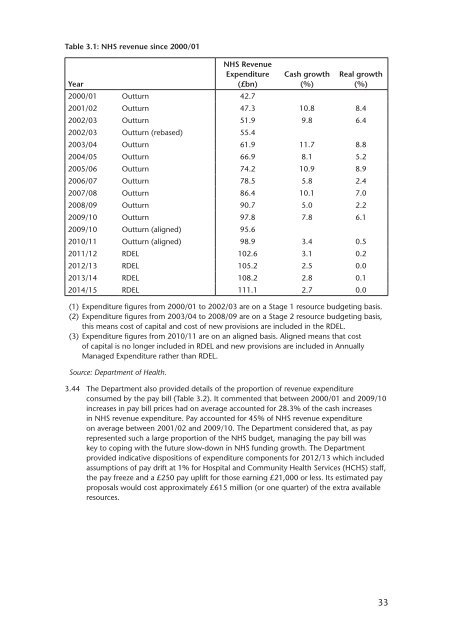NHS pay review body: twenty-sixth report 2012 - Official Documents
NHS pay review body: twenty-sixth report 2012 - Official Documents
NHS pay review body: twenty-sixth report 2012 - Official Documents
Create successful ePaper yourself
Turn your PDF publications into a flip-book with our unique Google optimized e-Paper software.
Table 3.1: <strong>NHS</strong> revenue since 2000/01<br />
Year<br />
<strong>NHS</strong> Revenue<br />
Expenditure<br />
(£bn)<br />
2000/01 Outturn 42.7<br />
Cash growth<br />
(%)<br />
Real growth<br />
(%)<br />
2001/02 Outturn 47.3 10.8 8.4<br />
2002/03 Outturn 51.9 9.8 6.4<br />
2002/03 Outturn (rebased) 55.4<br />
2003/04 Outturn 61.9 11.7 8.8<br />
2004/05 Outturn 66.9 8.1 5.2<br />
2005/06 Outturn 74.2 10.9 8.9<br />
2006/07 Outturn 78.5 5.8 2.4<br />
2007/08 Outturn 86.4 10.1 7.0<br />
2008/09 Outturn 90.7 5.0 2.2<br />
2009/10 Outturn 97.8 7.8 6.1<br />
2009/10 Outturn (aligned) 95.6<br />
2010/11 Outturn (aligned) 98.9 3.4 0.5<br />
2011/12 RDEL 102.6 3.1 0.2<br />
<strong>2012</strong>/13 RDEL 105.2 2.5 0.0<br />
2013/14 RDEL 108.2 2.8 0.1<br />
2014/15 RDEL 111.1 2.7 0.0<br />
(1) Expenditure figures from 2000/01 to 2002/03 are on a Stage 1 resource budgeting basis.<br />
(2) Expenditure figures from 2003/04 to 2008/09 are on a Stage 2 resource budgeting basis,<br />
this means cost of capital and cost of new provisions are included in the RDEL.<br />
(3) Expenditure figures from 2010/11 are on an aligned basis. Aligned means that cost<br />
of capital is no longer included in RDEL and new provisions are included in Annually<br />
Managed Expenditure rather than RDEL.<br />
Source: Department of Health.<br />
3.44 The Department also provided details of the proportion of revenue expenditure<br />
consumed by the <strong>pay</strong> bill (Table 3.2). It commented that between 2000/01 and 2009/10<br />
increases in <strong>pay</strong> bill prices had on average accounted for 28.3% of the cash increases<br />
in <strong>NHS</strong> revenue expenditure. Pay accounted for 45% of <strong>NHS</strong> revenue expenditure<br />
on average between 2001/02 and 2009/10. The Department considered that, as <strong>pay</strong><br />
represented such a large proportion of the <strong>NHS</strong> budget, managing the <strong>pay</strong> bill was<br />
key to coping with the future slow-down in <strong>NHS</strong> funding growth. The Department<br />
provided indicative dispositions of expenditure components for <strong>2012</strong>/13 which included<br />
assumptions of <strong>pay</strong> drift at 1% for Hospital and Community Health Services (HCHS) staff,<br />
the <strong>pay</strong> freeze and a £250 <strong>pay</strong> uplift for those earning £21,000 or less. Its estimated <strong>pay</strong><br />
proposals would cost approximately £615 million (or one quarter) of the extra available<br />
resources.<br />
33
















